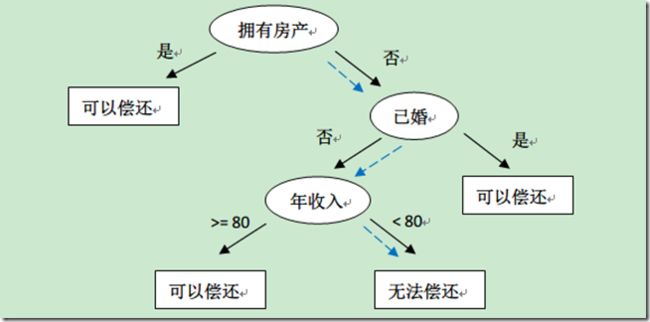决策树实战:从原理到实现
主要内容:
1. 决策树简介
2. 决策树的构建算法
3. python实现决策树
4. 扩展
5. 代码附录
6 .参考资料
决策树(decision tree) 是一种基本的分类和回归方法,决策树的学习包括3个步骤:特征选择、决策树的生成和决策树的剪枝。本文讨论决策树用作分类的原理和ID3算法的python实现。
1.决策树
决策树模型是一种描述对实例进行分类的树形结构。决策树由节点和有向边组成。节点有内部节点(internal node)和叶子节点(leaf node),内部节点表示一个特征(feature),叶子节点(node)表示一个类(label)。有向边表示相应特征的取值。如图所示是判断一个是否能够有偿还债务的能力的决策树:
2. 如何从历史数据构建决策树
如何一步步构建决策树,关键是找出相应的节点和边。我们需要解决的第一个问题就是,当前数据集上哪个特征在划分数据分类时起决定性作用。为了找出决定性的特征,划分出最好的结果,必须评估每个特征。信息增益石一种有效的评估方法。
2.1.信息增益(information gain)
信息增益表示得知特征X的信息而使得类Y的信息的不确定性减少程度
g(D,A)=H(D)-H(D|A)
H(D)数据D的经验熵, H(D|A) 特征A给定条件下D的经验条件熵, 也称为互信息,决策树学习中的信息增益等价于训练数据集中类与特征的互信息
基于信息增益准则的特征选择方法是:对训练数据集D,计算其每个特征的信息增益熵, 选择信息增益最大的特征。
信息增益算法:
2.2 决策树的生产
算法流程:
3. 实战决策树
首先获取数据:
def createDataSet():
#dataSet=pd.read_csv(datafile)
# label=[]
dataSet=[[1,1,'yes'],[1,1,'yes'],[1,0,'no'],[0,1,'no'],[0,1,'no']]
labels=['no surfacing','flippers']
return dataSet, labels根据数据递归生成树:
def createTree(dataSet,labels):
classList=[example[-1] for example in dataSet]
if classList.count(classList[0])==len(classList):
return classList[0] #如果改子集全部是同一类,返回该类
if len(dataSet[0])==1:
return majorityCnt(classList) #返回叶子节点的值
bestFeat=chooseBestFeatureToSplit(dataSet) #选取最佳特征
bestFeatLabel=labels[bestFeat]
myTree={bestFeatLabel:{}}
del (labels[bestFeat])
featValues=[example[bestFeat] for example in dataSet]
uniqueVals=set(featValues)
for value in uniqueVals:
subLabels=labels[:]
myTree[bestFeatLabel][value]=createTree(splitDataSet\ #递归调用,采用字典方式存储树的结构
(dataSet,bestFeat,value),subLabels)
return myTree计算决策用到的子函数:
计算给定数据集的香农熵:
def calcShannonEnt(dataSet):
numEntries=len(dataSet)
labelCounts={}
for featVec in dataSet:
currentLabel=featVec[-1]
#计算feature值的频数,为所有可能的类创建字典
if currentLabel not in labelCounts.keys():
labelCounts[currentLabel]=0
labelCounts[currentLabel]+=1
shannonEnt=0.0
#计算Shannon entropy
for key in labelCounts:
prob=float(labelCounts[key])/numEntries
shannonEnt-=prob*log(prob,2)
return shannonEnt分割数据
def splitDataSet(dataSet, axis, value):
retDataSet=[]
for featVec in dataSet:
if featVec[axis]==value:
reducedFeatVec=featVec[:axis]
reducedFeatVec.extend(featVec[axis+1:])
retDataSet.append(reducedFeatVec)
return retDataSet选择最好的特征进行分割数据
def chooseBestFeatureToSplit(dataSet):
numFeatures=len(dataSet[0])-1
baseEntropy=calcShannonEnt(dataSet)
bestInfoGain=0.0; bestFeature=-1;
for i in range(numFeatures):
featList=[example[i] for example in dataSet]
uniqueVals=set(featList)
newEntropy=0.0
#计算每一种划分方式的信息熵
for value in uniqueVals:
subDataSet=splitDataSet(dataSet,i,value)
prob=len(subDataSet)/float(len(dataSet))
newEntropy+=prob*calcShannonEnt(subDataSet)
#信息增益熵
infoGain=baseEntropy - newEntropy
#最好信息增益
if(infoGain>bestInfoGain):
bestInfoGain=infoGain
bestFeature=i
return bestFeature
#统计数据集出现频率最高的label
def majorityCnt(classList):
classCount={}
for vote in classList:
if vote not in classCount.keys(): classCount[vote]=0
classCount[vote]+=1
sortedClassCount=sorted(classCount.iteritems(),\
key=operator.itemgetter(1), reverse=True)
return sortedClassCount[0][0]5.附录代码:.
5.1 trees.py
# -*- coding: utf-8 -*-
"""
Created on Fri Apr 03 09:13:58 2015
@author: beta
"""
from math import log
import operator
import treePlotter
def calcShannonEnt(dataSet):
numEntries=len(dataSet)
labelCounts={}
for featVec in dataSet:
currentLabel=featVec[-1]
#计算feature值的频数,为所有可能的类创建字典
if currentLabel not in labelCounts.keys():
labelCounts[currentLabel]=0
labelCounts[currentLabel]+=1
shannonEnt=0.0
#计算Shannon entropy
for key in labelCounts:
prob=float(labelCounts[key])/numEntries
shannonEnt-=prob*log(prob,2)
return shannonEnt
def createDataSet():
#dataSet=pd.read_csv(datafile)
# label=[]
dataSet=[[1,1,'yes'],[1,1,'yes'],[1,0,'no'],[0,1,'no'],[0,1,'no']]
labels=['no surfacing','flippers']
return dataSet, labels
def splitDataSet(dataSet, axis, value):
retDataSet=[]
for featVec in dataSet:
if featVec[axis]==value:
reducedFeatVec=featVec[:axis]
reducedFeatVec.extend(featVec[axis+1:])
retDataSet.append(reducedFeatVec)
return retDataSet
def chooseBestFeatureToSplit(dataSet):
numFeatures=len(dataSet[0])-1
baseEntropy=calcShannonEnt(dataSet)
bestInfoGain=0.0; bestFeature=-1;
for i in range(numFeatures):
featList=[example[i] for example in dataSet]
uniqueVals=set(featList)
newEntropy=0.0
#计算每一种划分方式的信息熵
for value in uniqueVals:
subDataSet=splitDataSet(dataSet,i,value)
prob=len(subDataSet)/float(len(dataSet))
newEntropy+=prob*calcShannonEnt(subDataSet)
#信息增益熵
infoGain=baseEntropy - newEntropy
#最好信息增益
if(infoGain>bestInfoGain):
bestInfoGain=infoGain
bestFeature=i
return bestFeature
def majorityCnt(classList):
classCount={}
for vote in classList:
if vote not in classCount.keys(): classCount[vote]=0
classCount[vote]+=1
sortedClassCount=sorted(classCount.iteritems(),\
key=operator.itemgetter(1), reverse=True)
return sortedClassCount[0][0]
def createTree(dataSet,labels):
classList=[example[-1] for example in dataSet]
if classList.count(classList[0])==len(classList):
return classList[0]
if len(dataSet[0])==1:
return majorityCnt(classList)
bestFeat=chooseBestFeatureToSplit(dataSet)
bestFeatLabel=labels[bestFeat]
myTree={bestFeatLabel:{}}
del (labels[bestFeat])
featValues=[example[bestFeat] for example in dataSet]
uniqueVals=set(featValues)
for value in uniqueVals:
subLabels=labels[:]
myTree[bestFeatLabel][value]=createTree(splitDataSet\
(dataSet,bestFeat,value),subLabels)
return myTree
if __name__=='__main__':
myDat, labels=createDataSet()
myTree=createTree(myDat,labels)
treePlotter.createPlot(myTree)
'''
Created on Oct 14, 2010
@author: Peter Harrington
'''
import matplotlib.pyplot as plt
decisionNode = dict(boxstyle="sawtooth", fc="0.8")
leafNode = dict(boxstyle="round4", fc="0.8")
arrow_args = dict(arrowstyle="<-")
def getNumLeafs(myTree):
numLeafs = 0
firstStr = myTree.keys()[0]
secondDict = myTree[firstStr]
for key in secondDict.keys():
if type(secondDict[key]).__name__=='dict':#test to see if the nodes are dictonaires, if not they are leaf nodes
numLeafs += getNumLeafs(secondDict[key])
else: numLeafs +=1
return numLeafs
def getTreeDepth(myTree):
maxDepth = 0
firstStr = myTree.keys()[0]
secondDict = myTree[firstStr]
for key in secondDict.keys():
if type(secondDict[key]).__name__=='dict':#test to see if the nodes are dictonaires, if not they are leaf nodes
thisDepth = 1 + getTreeDepth(secondDict[key])
else: thisDepth = 1
if thisDepth > maxDepth: maxDepth = thisDepth
return maxDepth
def plotNode(nodeTxt, centerPt, parentPt, nodeType):
createPlot.ax1.annotate(nodeTxt, xy=parentPt, xycoords='axes fraction',
xytext=centerPt, textcoords='axes fraction',
va="center", ha="center", bbox=nodeType, arrowprops=arrow_args )
def plotMidText(cntrPt, parentPt, txtString):
xMid = (parentPt[0]-cntrPt[0])/2.0 + cntrPt[0]
yMid = (parentPt[1]-cntrPt[1])/2.0 + cntrPt[1]
createPlot.ax1.text(xMid, yMid, txtString, va="center", ha="center", rotation=30)
def plotTree(myTree, parentPt, nodeTxt):#if the first key tells you what feat was split on
numLeafs = getNumLeafs(myTree) #this determines the x width of this tree
depth = getTreeDepth(myTree)
firstStr = myTree.keys()[0] #the text label for this node should be this
cntrPt = (plotTree.xOff + (1.0 + float(numLeafs))/2.0/plotTree.totalW, plotTree.yOff)
plotMidText(cntrPt, parentPt, nodeTxt)
plotNode(firstStr, cntrPt, parentPt, decisionNode)
secondDict = myTree[firstStr]
plotTree.yOff = plotTree.yOff - 1.0/plotTree.totalD
for key in secondDict.keys():
if type(secondDict[key]).__name__=='dict':#test to see if the nodes are dictonaires, if not they are leaf nodes
plotTree(secondDict[key],cntrPt,str(key)) #recursion
else: #it's a leaf node print the leaf node
plotTree.xOff = plotTree.xOff + 1.0/plotTree.totalW
plotNode(secondDict[key], (plotTree.xOff, plotTree.yOff), cntrPt, leafNode)
plotMidText((plotTree.xOff, plotTree.yOff), cntrPt, str(key))
plotTree.yOff = plotTree.yOff + 1.0/plotTree.totalD
#if you do get a dictonary you know it's a tree, and the first element will be another dict
def createPlot(inTree):
fig = plt.figure(1, facecolor='white')
fig.clf()
axprops = dict(xticks=[], yticks=[])
createPlot.ax1 = plt.subplot(111, frameon=False, **axprops) #no ticks
#createPlot.ax1 = plt.subplot(111, frameon=False) #ticks for demo puropses
plotTree.totalW = float(getNumLeafs(inTree))
plotTree.totalD = float(getTreeDepth(inTree))
plotTree.xOff = -0.5/plotTree.totalW; plotTree.yOff = 1.0;
plotTree(inTree, (0.5,1.0), '')
plt.show()
#def createPlot():
# fig = plt.figure(1, facecolor='white')
# fig.clf()
# createPlot.ax1 = plt.subplot(111, frameon=False) #ticks for demo puropses
# plotNode('a decision node', (0.5, 0.1), (0.1, 0.5), decisionNode)
# plotNode('a leaf node', (0.8, 0.1), (0.3, 0.8), leafNode)
# plt.show()
def retrieveTree(i):
listOfTrees =[{'no surfacing': {0: 'no', 1: {'flippers': {0: 'no', 1: 'yes'}}}},
{'no surfacing': {0: 'no', 1: {'flippers': {0: {'head': {0: 'no', 1: 'yes'}}, 1: 'no'}}}}
]
return listOfTrees[i]
#createPlot(thisTree)6.参考资料:
1. 李航 《统计学习方法》
2.. Peter Harrington 《机器学习实战》
